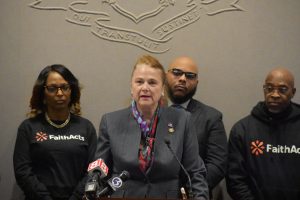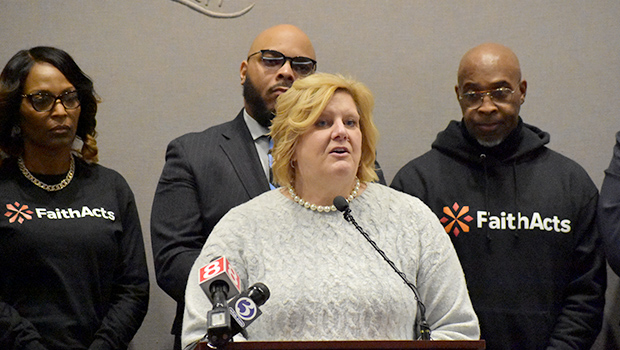At a news conference at the Legislative Office Building this morning calling for more school funding that reaches classrooms, raises teacher salaries, and creates systemic change, CEA President Kate Dias drove home the message that now is the time, and a rising tide lifts all boats.
The news conference, organized by a coalition of legislators and education stakeholders, came before a public hearing that will take up various measures in House Bill 5003, An Act Concerning Education Funding in Connecticut. Among other things, the proposed legislation seeks to fully fund municipalities previously underfunded by the Education Cost Sharing formula as well as ensure that increases in funding are spent on supporting students and teachers, reducing class sizes, and recruiting and retaining high-quality educators.
The hearing is anticipated to be one of the largest in the Connecticut General Assembly’s recent history.

House Speaker Matthew Ritter applauds bipartisan support for school funding.
Big, bold action
“I am here today primarily to continue to draw attention not only to the tremendous work being done by educators in classrooms across the state but also to the reality that their experience is not consistent,” said Dias. “I come from a town that has worked really hard to drive class sizes down, but my class size experience started at 30 students. I have colleagues who work in more affluent districts where that is not their practical reality. I work in a classroom that is not air conditioned, that we refer to as ‘the sauna’ when it warms up in June. I have colleagues across the state who would never have that experience; it’s just not their world. Money would come in, and air conditioners would be purchased. And those differences shouldn’t be the experience for our teachers and our students across the state. We should be talking about education in terms of the parity that it can bring to our experiences.”
She added, “We can’t look at doing education on the cheap and wonder why people move out of this state. We can’t look at education in our cities and say, ‘What can we cut?’ and then ask why people don’t want to move their companies to our cities. We can’t continuously separate these issues. From my perspective, 74 percent of our teachers are saying, ‘I’ve had enough.’ I consider this year one of the highest-stakes negotiations we have ever had. We need big action that brings teachers back to the table. So, what are we going to do? It’s not going to be throwing a couple of bucks here and there, patting us on the back, and saying, ‘What a great job you’ve done.’ We’re done with that, folks. We need big, bold moves. Let’s not be scared when we talk about $287 million in the context of a multibillion-dollar budget. Education should be the only thing we’re focused on, because it is the centerpiece of everything we want to achieve.”

Education Committee Co-Chair Jeff Currey vows to give school districts “everything they need to provide a high-quality learning experience.”
Speaker of the House Matthew Ritter, whose children attend Hartford public schools, said, “I see the inequities all too well. I can tell you the schools my kids go to are vastly better than the schools some people I represent go to, only a mile away.” Ritter pointed to overwhelming bipartisan support for more school funding and said, “The goal is not for one year, but in perpetuity.”
He added, “With additional funding should come additional measures to make sure we know how the funding is spent.”
“This fight is so important right now,” said Rep. Jeff Currey, co-chair of the Education Committee. “We are at a moment in the state of Connecticut in which education is finally a priority for everyone in this building.” Currey called on legislators to give underfunded, underresourced districts “everything they need to provide a high-quality learning experience for every child, every day, regardless of their ZIP code.”
One-time infusions of federal dollars into the state’s schools are not enough to make long-term, sustainable change, he said, explaining that school districts are using those federal dollars for much-needed support staff, resources, and “everything that already should have been in their classrooms but was not, because of funding issues.”
Closing the gap

Rep. Kathleen McCarty stresses the need to close the state’s opportunity gap.
Calling educational disparities “a persistent, recalcitrant opportunity gap in this state,” Rep. Kathleen McCarty, ranking member of the legislature’s Education Committee, stressed the need for funding that is transparent, fair, and effective at addressing the learning needs of all students.
“Every single child in the state of Connecticut deserves a quality education,” McCarty said, “and education needs to be the number-one priority in our state.”
Hartford Mayor Luke Bronin applauded a “funding formula that doesn’t come at a cost to our public schools” and that recognizes differences in needs among districts, which include greater poverty levels, higher populations of English learners, and more.
“We cannot afford to leave kids behind in any community across Connecticut, and only through a fully funded state Education Cost Sharing formula can we achieve that,” Senate Majority Leader Bob Duff agreed.
HB 5003 is one vehicle among many bills the legislature will be considering to address public school funding. CEA is fighting to ensure that a final package provides an investment in our schools that is significant and done in a way that ensures class size reduction, more attractive teacher salaries, and resources targeted to making classrooms better places to teach and learn.







